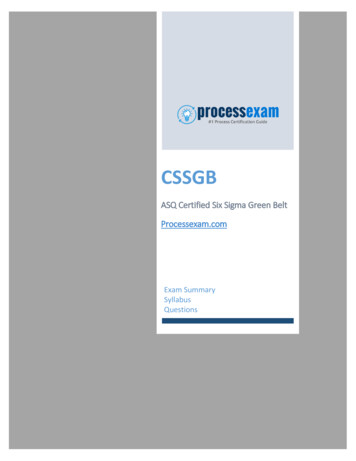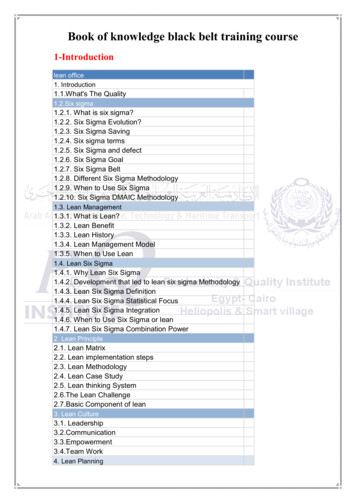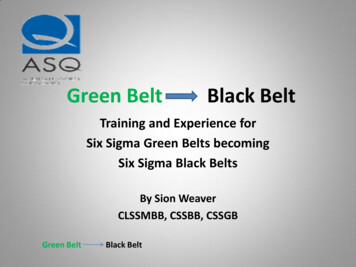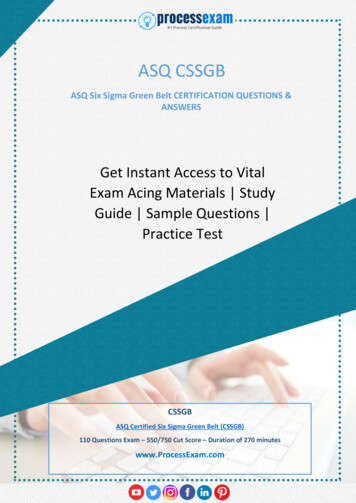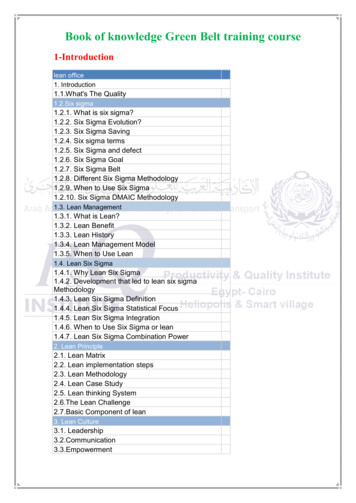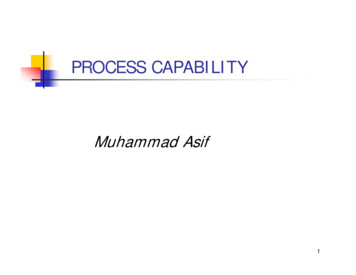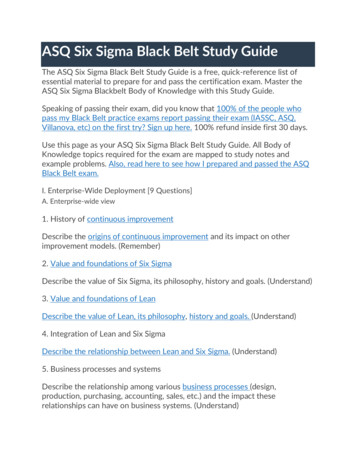
Transcription
ASQ Six Sigma Black Belt Study GuideThe ASQ Six Sigma Black Belt Study Guide is a free, quick-reference list ofessential material to prepare for and pass the certification exam. Master theASQ Six Sigma Blackbelt Body of Knowledge with this Study Guide.Speaking of passing their exam, did you know that 100% of the people whopass my Black Belt practice exams report passing their exam (IASSC, ASQ,Villanova, etc) on the first try? Sign up here. 100% refund inside first 30 days.Use this page as your ASQ Six Sigma Black Belt Study Guide. All Body ofKnowledge topics required for the exam are mapped to study notes andexample problems. Also, read here to see how I prepared and passed the ASQBlack Belt exam.I. Enterprise-Wide Deployment [9 Questions]A. Enterprise-wide view1. History of continuous improvementDescribe the origins of continuous improvement and its impact on otherimprovement models. (Remember)2. Value and foundations of Six SigmaDescribe the value of Six Sigma, its philosophy, history and goals. (Understand)3. Value and foundations of LeanDescribe the value of Lean, its philosophy, history and goals. (Understand)4. Integration of Lean and Six SigmaDescribe the relationship between Lean and Six Sigma. (Understand)5. Business processes and systemsDescribe the relationship among various business processes (design,production, purchasing, accounting, sales, etc.) and the impact theserelationships can have on business systems. (Understand)
6. Six sigma and Lean applicationsDescribe how these tools are applied to processes in all types of enterprises:manufacturing, service, transactional, product and process design, innovation,etc. (Understand)B. Leadership1. Enterprise leadership responsibilitiesDescribe the responsibilities of executive leaders and how they affectthe deployment of Six Sigma in terms of providing resources, managingchange, communicating ideas, etc. (Understand)2. Organizational roadblocksDescribe the impact an organization’s culture and inherent structure can haveon the success of Six Sigma, and how deployment failure can result from thelack of resources, management support, etc.; identify and apply varioustechniques to overcome these barriers. Critical Success Factors to SixSigma (Apply)3. Change managementDescribe and use various techniques for facilitating and managingorganizational change. (Apply)4. Six Sigma projects and kaizen eventsDescribe how projects and kaizen events are selected, when to use Six Sigmainstead of other problem-solving approaches, and the importance of aligningtheir objectives with organizational goals. (Apply)5. Six Sigma roles and responsibilitiesDescribe the roles and responsibilities of Six Sigma participants: blackbelt, master black belt, green belt, champion, process owners and projectsponsors. (Understand)
II. Organizational Process Management and Measures [9 Questions]A.Impact on stakeholdersDescribe the impact Six Sigma projects can have on customers, suppliers andother stakeholders. (Understand)B. Criticalto x (CTx) requirementsDefine and describe various CTx requirements (critical to quality (CTQ), cost(CTC), process (CTP), safety (CTS), delivery (CTD), etc.) and the importance ofaligning projects with those requirements. (Apply)Critical to ClientCritical to Quality TreeC. BenchmarkingDefine and distinguish between various types of benchmarking, including bestpractices, competitive, collaborative, etc. (Apply)D. Business performance measuresDefine and describe various business performance measures, includingbalanced scorecard, key performance indicators (KPIs), the financial impact ofcustomer loyalty, etc. (Understand)E. Financial measuresDefine and use financial measures, including revenue growth, market share,margin, cost of quality (COQ), net present value (NPV), return on investment(ROI), cost benefit analysis, etc. (Apply)III. Team Management [16 Questions]A. Team formation1. Team types and constraintsDefine and describe various types of teams (e.g., formal, informal, virtual,cross-functional, self-directed, etc.), and determine what team model will work
best for a given situation. Identify constraining factors including geography,technology, schedules, etc. (Apply)2. Team rolesDefine and describe various team roles and responsibilities, including leader,facilitator, coach, individual member, etc. (Understand)3. Team member selectionDefine and describe various factors that influence the selection of teammembers, including required skills sets, subject matter expertise, availability,etc. (Apply)4. Launching teamsIdentify and describe the elements required for launching a team, includinghaving management support, establishing clear goals, ground rules andtimelines, and how these elements can affect the team’s success. (Apply)B. Team facilitation1. Team motivationDescribe and apply techniques that motivate team members and support andsustain their participation and commitment. (Apply)2. Team stagesFacilitate the team through the classic stages of development: forming,storming, norming, performing and adjourning. (Apply)3. Team communicationIdentify and use appropriate communication methods (both within the teamand from the team to various stakeholders) to report progress, conductmilestone reviews and support the overall success of the project. (Apply)
C.Team dynamicsIdentify and use various techniques (e.g., coaching, mentoring, intervention,etc.) to overcome various group dynamic challenges, includingoverbearing/dominant or reluctant participants, feuding and other forms ofunproductive disagreement, unquestioned acceptance of opinions as facts,group-think, floundering, rushing to accomplish or finish, digressions, tangents,etc. (Evaluate)D. Time management for teamsSelect and use various time management techniques including publishingagendas with time limits on each entry, adhering to the agenda, requiring prework by attendees, ensuring that the right people and resources are available,etc. (Apply)E. Team decision-making toolsDefine, select and use tools such as brainstorming, nominal grouptechnique, multi-voting, etc. (Apply)F. Management and planning toolsDefine, select and apply the following tools: affinity diagrams, treediagrams, process decision program charts (PDPC), matrixdiagrams, interrelationship digraphs, prioritization matrices and activitynetwork diagrams. (Apply)G. Team performance evaluation and rewardMeasure team progress in relation to goals, objectives and other metrics thatsupport team success and reward and recognize the team for itsaccomplishments. (Analyze)IV. Define [15 Questions]A. Voice of the customer1. Customer identificationSegment customers for each project and show how the project will impactboth internal and external customers. (Apply)
2. Customer feedbackIdentify and select the appropriate data collection method (surveys, focusgroups, interviews, observation, etc.) to gather customer feedback to betterunderstand customer needs, expectations and requirements. Ensure that theinstruments used are reviewed for validity and reliability to avoid introducingbias or ambiguity in the responses. (Apply)3. Customer requirementsDefine, select and use appropriate tools to determine customer requirements,such as CTQ flow-down, quality function deployment (QFD) and the Kanomodel. (Apply)B. Projectcharter1. Problem statementDevelop and evaluate the problem statement in relation to the project’sbaseline performance and improvement goals. (Create)2. Project scopeDevelop and review project boundaries to ensure that the project has value tothe customer. (Analyze)3. Goals and objectivesDevelop the goals and objectives for the project on the basis of the problemstatement and scope. (Apply)4. Project performance measuresIdentify and evaluate performance measurements (e.g., cost, revenue,schedule, etc.) that connect critical elements of the process to key outputs.(Analyze)C. Project trackingIdentify, develop and use project management tools, such as schedules, Ganttcharts, toll-gate reviews, etc., to track project progress.
Also see Project Management.(Create)V. Measure [26 Questions]A. Process characteristics1. Input and output variablesIdentify these process variables and evaluate their relationshipsusing SIPOC and other tools. (Evaluate)2. Process flow metricsEvaluate process flow and utilization to identify waste and constraints byanalyzing work in progress (WIP), work in queue (WIQ), touch time, takt time,cycle time, throughput, etc. (Evaluate)3. Process analysis toolsAnalyze processes by developing and using value stream maps, processmaps, flowcharts, procedures, work instructions, spaghetti diagrams, circlediagrams, etc. (Analyze)B. Datacollection1. Types of dataDefine, classify and evaluate qualitative and quantitative data, continuous(variables) and discrete (attributes) data and convert attributes data tovariables measures when appropriate. (Evaluate)2. Measurement scalesDefine and apply nominal, ordinal, interval and ratio measurementscales. (Apply)3. Sampling methodsDefine and apply the concepts related to sampling (e.g., representativeselection, homogeneity, bias, etc.).
Select and use appropriate sampling methods (e.g., random sampling, stratifiedsampling, systematic sampling, etc.) that ensure the integrity of data. (Evaluate)4. Collecting dataDevelop data collection plans, including consideration of how the data will becollected (e.g., check sheets, data coding techniques, automated datacollection, etc.) and how it will be used. (Apply)C. Measurement systems1. Measurement methodsDefine and describe measurement methods for both continuous and discretedata. (Understand)2. Measurement systems analysisUse various analytical methods (e.g., repeatability and reproducibility(R&R), correlation, bias, linearity, precision to tolerance, percent agreement,etc.) to analyze and interpret measurement system capability for variables andattributes measurement systems. (Evaluate)3. Measurement systems in the enterpriseIdentify how measurement systems can be applied in marketing, sales,engineering, research and development (R&D), supply chain management,customer satisfaction and other functional areas. (Understand)4. MetrologyDefine and describe elements of metrology, including calibration systems,traceability to reference standards, the control and integrity of standards andmeasurement devices, etc. (Understand)D. Basic statistics1. Basic termsDefine and distinguish between population parameters and sample statistics(e.g., proportion, mean, standard deviation, etc.) (Apply)
2. Central limit theoremDescribe and use this theorem and apply the sampling distribution of the meanto inferential statistics for confidence intervals, control charts, etc. (Apply)3. Descriptive statisticsCalculate and interpret measures of dispersion and central tendency andconstruct and interpret frequency distributions and cumulative frequencydistributions. (Evaluate)4. Graphical methodsConstruct and interpret diagrams and charts, including box-and-whiskerplots, run charts, scatter diagrams, histograms, normal probability plots, etc.(Evaluate)5. Valid statistical conclusionsDefine and distinguish between enumerative (descriptive) and analytic(inferential) statistical studies and evaluate their results to draw validconclusions. (Evaluate)E. Probability1. Basic conceptsDescribe and apply probability concepts such as independence, mutuallyexclusive events, multiplication rules, complementary probability, jointoccurrence of events, etc. (Apply)2. Commonly used distributionsDescribe, apply and interpret the followingdistributions: normal, Poisson, binomial, chi square, Student’s t and Fdistributions. (Evaluate)3. Other distributions
Describe when and how to use the followingdistributions: hypergeometric, bivariate, exponential, lognormal and Weibull.(Apply)F. Process capability1. Process capability indicesDefine, select and calculate Cp and Cpk to assess process capability. (Evaluate)2. Process performance indicesDefine, select and calculate Pp, Ppk and Cpm to assess processperformance. (Evaluate)3. Short-term and long-term capabilityDescribe and use appropriate assumptions and conventions when only shortterm data or attributes data are available and when long-term data areavailable. Interpret the relationship between long-term and short-termcapability. (Evaluate)4. Process capability for non-normal dataIdentify non-normal data and determine when it is appropriate to use BoxCox or other transformation techniques. (Apply)5. Process capability for attributes dataCalculate the process capability and process sigma level for attributes data.(Apply)6. Process capability studiesDescribe and apply elements of designing and conducting process capabilitystudies, including identifying characteristics and specifications, developingsampling plans and verifying stability and normality. (Evaluate)7. Process performance vs. specificationDistinguish between natural process limits and specification limits, andcalculate process performance metrics such as percent defective, parts per
million (PPM), defects per million opportunities (DPMO), defects per unit(DPU), process sigma, rolled throughput yield (RTY), etc. (Evaluate)VI. Analyze [24 Questions]A. Measuring and modeling relationships between variables1. Correlation coefficientCalculate and interpret the correlation coefficient and its confidence interval,and describe the difference between correlation and causation. (Analyze)NOTE: Serial correlation will not be tested.2. RegressionCalculate and interpret regression analysis, and apply and interpret hypothesistests for regression statistics. Use the regression model for estimation andprediction, analyze the uncertainty in the estimate, and perform a residualsanalysis to validate the model. (Evaluate) NOTE: Models that have non-linearparameters will not be tested. Linear RegressionLogisitic RegressionMultiple Linear Regression3. Multivariate toolsUse and interpret multivariate tools such as principal components, factoranalysis, discriminant analysis, multiple analysis of variance (MANOVA), etc., toinvestigate sources of variation. (Analyze)4. Multi-vari studiesUse and interpret charts of these studies and determine the differencebetween positional, cyclical and temporal variation. (Analyze)5. Attributes data analysisAnalyze attributes data using logit, probit, logistic regression, etc., toinvestigate sources of variation. (Analyze)
B. Hypothesis testing1. TerminologyDefine and interpret the significance level, power, type I and type II errors ofstatistical tests. (Evaluate)2. Statistical vs. practical significanceDefine, compare and interpret statistical and practical significance. (Evaluate)3. Sample sizeCalculate sample size for common hypothesis tests (e.g., equality of means,equality of proportions, etc.). (Apply)4. Point and interval estimatesDefine and distinguish between confidence and prediction intervals. Defineand interpret the efficiency and bias of estimators. Calculate tolerance andconfidence intervals. (Evaluate)5. Tests for means, variances and proportionsUse and interpret the results of hypothesis tests for means, variances andproportions. (Evaluate)6. Analysis of variance (ANOVA)Select, calculate and interpret the results of ANOVAs. (Evaluate)7. Goodness-of-fit (chi square) testsDefine, select and interpret the results of these tests. (Evaluate)8. Contingency tables Select, develop and use contingency tables to determinestatistical significance. (Evaluate)9. Non-parametric tests
Select, develop and use various non-parametric tests, including Mood’sMedian, Levene’s test, Kruskal-Wallis, Mann-Whitney, etc. (Evaluate)C. Failuremode and effects analysis (FMEA)Describe the purpose and elements of FMEA, including risk priority number(RPN), and evaluate FMEA results for processes, products and services.Distinguish between design FMEA (DFMEA) and process FMEA (PFMEA), andinterpret results from each. (Evaluate)D. Additional analysis methods1. Gap analysisUse various tools and techniques (gap analysis, scenario planning, etc.) tocompare the current and future state in terms of pre-defined metrics. (Analyze)2. Root cause analysisDefine and describe the purpose of root cause analysis, recognize the issuesinvolved in identifying a root cause, and use various tools (e.g., the 5whys, Pareto charts, fault tree analysis, cause and effect diagrams, etc.) forresolving chronic problems. (Evaluate)3. Waste analysisIdentify and interpret the 7 classic wastes (overproduction, inventory, defects,over-processing, waiting, motion and transportation) and other forms of wastesuch as resource under-utilization, etc. (Analyze)VII. Improve [23 Questions]A. Design of experiments (DOE)1. TerminologyDefine basic DOE terms, including independent and dependent variables,factors and levels, response, treatment, error, etc. (Understand)2. Design principles
Define and apply DOE principles, including power and sample size, balance,repetition, replication, order, efficiency, randomization, blocking,interaction, confounding, resolution, etc. (Apply)3. Planning experimentsPlan, organize and evaluate experiments by determining the objective,selecting factors, responses and measurement methods, choosing theappropriate design, etc. (Evaluate)4. One-factor experimentsDesign and conduct completely randomized, randomized block and Latinsquare designs and evaluate their results. (Evaluate)5. Two-level fractional factorial experimentsDesign, analyze and interpret these types of experiments and describe howconfounding affects their use. (Evaluate)6. Full factorial experimentsDesign, conduct and analyze full factorial experiments. (Evaluate)B. Waste eliminationSelect and apply tools and techniques for eliminating or preventing waste,including pull systems, kanban, 5S, standard work, poka-yoke, etc. (Analyze)C. Cycle-time reductionUse various tools and techniques for reducing cycle time, including continuousflow, single-minute exchange of die (SMED), etc. (Analyze)D. Kaizen and kaizen blitzDefine and distinguish between these two methods and apply them in varioussituations. (Apply)
E. Theory of constraints (TOC)Define and describe this concept and its uses. (Understand)F. ImplementationDevelop plans for implementing the improved process (i.e., conduct pilot tests,simulations, etc.), and evaluate results to select the optimum solution.(Evaluate)G. Risk analysis and mitigationUse tools such as feasibility studies, SWOT analysis (strengths, weaknesses,opportunities and threats), PEST analysis (political, environmental, social andtechnological) and consequential metrics to analyze and mitigate risk. (Apply)VIII. Control [21 Questions]A. Statistical process control (SPC)1. ObjectivesDefine and describe the objectives of SPC, including monitoring andcontrolling process performance, tracking trends, runs, etc., and reducingvariation in a process. (Understand)2. Selection of variablesIdentify and select critical characteristics for control chart monitoring. (Apply)3. Rational subgroupingDefine and apply the principle of rational subgrouping. (Apply)4. Control chart selectionSelect and use the following control charts in various situations: X – R, X –s, individual and moving range (ImR), attribute charts (p, np, c, u), short-run SPCand moving average. (Apply)5. Control chart analysis
Interpret control charts and distinguish between common and specialcauses using rules for determining statistical control. (Analyze)B. Other control tools1. Total productive maintenance (TPM)Define the elements of TPM and describe how it can be used to control theimproved process. (Understand)2. Visual factoryDefine the elements of a visual factory and describe how they can help controlthe improved process. (Understand)C. Maintain controls1. Measurement system re-analysisReview and evaluate measurement system capability as processcapability improves, and ensure that measurement capability is sufficient for itsintended use. (Evaluate)2. Control planDevelop a control plan for ensuring the ongoing success of the improvedprocess including the transfer of responsibility from the project team to theprocess owner. (Apply)D. Sustain improvements1. Lessons learnedDocument the lessons learned from all phases of a project and identify howimprovements can be replicated and applied to other processes in theorganization. (Apply)2. Training plan deploymentDevelop and implement training plans to ensure continued support of theimproved process. (Apply)
3. DocumentationDevelop or modify documents including standard operating procedures (SOPs),work instructions, etc., to ensure that the improvements are sustained overtime. (Apply)4. Ongoing evaluationIdentify and apply tools for ongoing evaluation of the improved process,including monitoring for new constraints, additional opportunities forimprovement, etc. (Apply)IX. Design for Six Sigma (DFSS) Frameworksand Methodologies [7 Questions]A. CommonDFSS methodologiesIdentify and describe these methodologies. (Understand)1. DMADV (define, measure, analyze, design and validate)2. DMADOV (define, measure, analyze, design, optimize and validate)B. Design for X (DFX)Describe design constraints, including design for cost, design formanufacturability and producibility, design for test, design for maintainability,etc. (Understand)C. Robust design and processDescribe the elements of robust product design, tolerance design andstatistical tolerancing. (Apply)D. Special design tools1. StrategicDescribe how Porter’s five forces analysis, portfolio architecting and othertools can be used in strategic design and planning. (Understand)
2. TacticalDescribe and use the theory of inventive problem-solving (TRIZ), systematicdesign, critical parameter management and Pugh analysis in designing productsor processes. (Apply)
The ASQ Six Sigma Black Belt Study Guide is a free, quick-reference list of essential material to prepare for and pass the certification exam. Master the ASQ Six Sigma Blackbelt Body of Knowledge with this Study Guide. Speaking of passing their exam, did you know that 100% of the people who pass my Black Belt practice exams report passing their .

